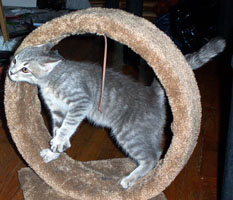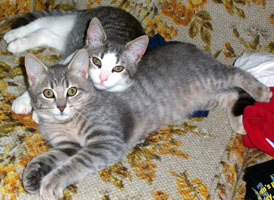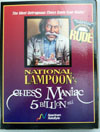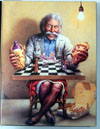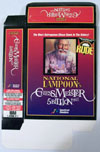Here is a game developer’s perspective on Formula One qualifying.
In Mark LaBlanc‘s workshop on game design at the recent Future Play conference, he discussed a design methodology called MDA, which stands for Mechanics – Dynamics – Aesthetics. Briefly, this is a way of thinking about a game, where mechanics are (broadly speaking) the actual rules of the game as established by the designer, which result in the dynamics, which are the (often emergent) tactics and strategies used in playing the game, leading to the aesthetics, the (hopefully enjoyable) experience of the player.
While watching the final race of the Formula One season, the Grand Prix of China, last weekend, still in the afterglow of the conference, the commentators mentioned that the qualifying format was going to be changed, yet again, next year. The FIA, the governing body for F1, the designers if you will, are essentially doing what our industry calls game balancing, although they are doing it on a public stage with, literally, billions of viewers worldwide. I found myself almost thoughtlessly applying MDA design to this issue.
Formula One has a qualifying problem. About five years ago, they changed the format for qualifying, which determines the starting positions for each race. In the previous format, each car ran during a specified period of time, with (potentially) all of the other cars on track. The car with the fastest lap (lowest elapsed time) overall started in pole position, and the rest were arranged in descending speed order based on each car’s fastest lap. These were the mechanics of the system.
The dynamics that emerged from this qualifying format were that, because the track was dusty at the beginning of the session, lap times got quicker toward the end, and because cars with less fuel are lighter, they are faster. The strategy then became to run as close to the end of the session with as little fuel as possible. This resulted in a lengthy period of no action on the track, followed by a frenzy of cars, making it hard for drivers to get a clean lap without getting held up by other cars. Additionally, because most of the cars were on track at the end, the television coverage only focused on the faster cars.
Unlike traditional game design, where the audience is the player, in spectator sports such as Formula One, the audience is, well, the audience. Whether or not the players of the sport, the drivers in this case, enjoy it is secondary. The aesthetics that resulted from the old qualifying format was that spectators were bored for the first half of the qualifying session, after which the television viewers only got to see a few cars, while those attending a race in person saw lots of cars on track. The drivers often complained about not getting a clean lap, although they enjoyed going as quickly as possible on those occasions when it did happen. Because Formula One is a business, there is also the consideration that the sponsors, especially those on the slower cars, did not like that their brands did not get much air time during qualifying (or the race, for that matter).
Over the past few seasons, the organizers experimented with the mechanics of the format to change the dynamics and hopefully produce better aesthetics. Last year, the format consisted of a pre-qualifying session in which cars ran on track one at a time, on low fuel, to compete for a good qualifying position, toward the end of the session. The actual qualifying was run the same way, with only one car qualifying on track at a time, but this time the car had to have race fuel. No refueling was allowed before the race, so the cars had to “run heavy”.
The resulting dynamics were very different. There was always some action on track, and the bulk of the strategy was related to how much fuel was on board during the qualifying, effecting how soon the car would have to stop in the race. On the aesthetic end, every driver got a clean lap, albeit with a heavier car, but the qualifying session was long and somewhat boring. Additionally, spectators did not know which was really the fastest car, as a team could run light on fuel just for a good qualifying lap (but have to stop early in the race). The sponsors were initially happy, because every car got individual coverage for two laps, but when spectators got bored with the length of the process, television networks stopped covering pre-qualifying, cutting sponsor air time in half.
The year, the qualifying format was pretty similar, mostly due to inertia on the issues. The only change to mechanics was that, instead of a pre-qualifying session, the qualifying order was set based on the results of the last race. The change in dynamics was that a bad performance in one race (such as a car breaking down) tended toward a poor qualifying performance for the next race, compromising that one… a vicious cycle. The aesthetic problems were mostly unaddressed, except that drivers became even more frustrated when affected by unreliability.
So, taking the issues mentioned above, I would propose the following changes to the Formula One qualifying format for the 2006 season:
First, allow refueling before the race. Although the unknown fuel level in each car allowed for some strategy, it was at the expense of the spectators knowing which was actually the fastest car. In truth, some of us true fans appreciate the strategic elements, but the bulk of the audience is merely confused. (This is also covered by a game design principle: Design a game for the audience, not simply for yourself.)
Second, set the qualifying order based on the fastest lap time in practice. This would allow the qualifying to be based solely on performance at that particular track, without unduly punishing drivers who did poorly at the previous race (or new drivers who did not compete there). There are currently four (4) practice sessions before qualifying, two each on Friday and Saturday, so this would make them more meaningful, beyond mere preparation work.
Finally, add a short, 15-minute, pre-qualifying session (fifth practice) immediately before qualifying. This would be a last chance session for getting a good qualifying position, and there is not enough time to mess around waiting for other cars to clean the track.
With these three changes to the mechanics of the qualifying system, I would expect to change the dynamics significantly. The refueling rule would allow cars to run as fast as possible, rather than compromising qualifying speed for race strategy. Using combined practice times for qualifying order makes the practices more meaningful and gives each driver lots of opportunity for getting a clean lap. The new pre-qualifying should add a session in which a frenzy of cars are all on track together trying to make a final improvement to their positions.
This should greatly improve the aesthetics. Spectators would be treated to the excitement of lots of cars on track for pre-qualifying, as well as outright speed of the single-lap qualifying session. Television broadcasters would show both pre-qualifying (short and exciting) and final qualifying (fast and important), and the qualifying session would still allow the cameras to focus on the sponsors for each car. Of course, the drivers love to go fast in qualifying so they, too, would be happy.
Perhaps this attempt at a “


